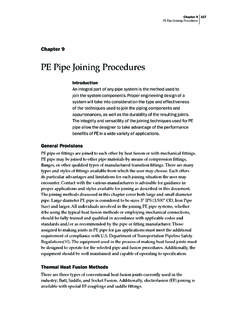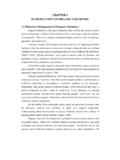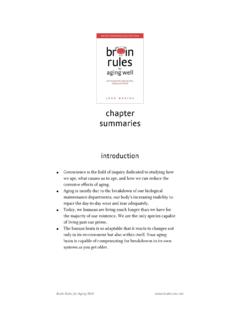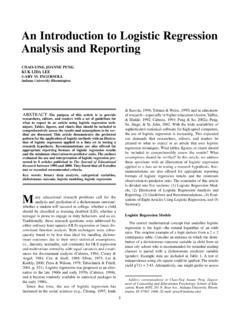Transcription of CHAPTER 8. TERMINATION 8-1 Introduction
1 HUD Occupancy Handbook 8-1 6/07 CHAPTER 8: TERMINATION REV-1 CHAPTER 8. TERMINATION 8-1 Introduction A. CHAPTER 8 addresses terminating housing assistance and terminating tenancy. Under program regulations and leases, TERMINATION of assistance occurs when a tenant is no longer eligible for subsidy or to enforce HUD program requirements. It results in the loss of subsidy to the tenant. Tenants whose assistance is terminated may remain in the unit, but they must pay the market rent, full contract rent, or 110% of BMIR rent. Owners are authorized to terminate assistance only in limited circumstances and after following required procedures to ensure that tenants have received proper notice and an opportunity to respond.
2 B. TERMINATION of tenancy is the first step in the eviction process and is often used interchangeably with the term eviction. When terminating tenancy, the owner gives the tenant notice to vacate the unit because of a lease violation(s). A tenant who fails to vacate the unit after receiving notice from the owner may face judicial action initiated by the owner to evict the tenant. The owner may only terminate tenancy in limited circumstances as prescribed by HUD regulations and the lease and must follow HUD and state/local procedures. C. Owners are expected to enforce program requirements under the terms of the lease. Similarly, HUD expects tenants to comply with the program requirements as established in the lease.
3 HUD encourages owners to work with tenants and utilize other corrective actions, such as repayment agreements or negotiated settlements, to resolve program/lease issues. Terminations represent only one of the tools available to owners for lease enforcement. Owners and tenants are advised that HUD TERMINATION policies and procedures must be followed when initiating a TERMINATION , including proper notices and documentation. Owners are also advised that terminations for reasons other than those permitted by HUD are prohibited. D. The CHAPTER is organized into the following four sections: Section 1: TERMINATION of Assistance outlines key requirements and procedures regarding when and how a tenant s assistance must be terminated.
4 Section 2: TERMINATION of Tenancy by Lessees discusses the tenant s responsibilities when the tenant wishes to terminate tenancy. Section 3: TERMINATION of Tenancy by Owners outlines allowable circumstances for terminating tenancy and the requirements and procedures that owners must follow to terminate a tenant s residency. Section 4: Discrepancies, Errors, and Fraud describe the circumstances when owners must investigate discrepancies and provides guidelines on how to distinguish tenant errors from fraud. It also identifies how to take action ( , documenting fraud and reimbursing HUD or the tenant). HUD Occupancy Handbook 8-2 8/13 CHAPTER 8: TERMINATION REV-1 8-2 Key Terms A.
5 There are a number of technical terms used in this CHAPTER that have very specific definitions established by federal statute or regulations or by HUD. These terms are listed in Figure 8-1, and their definitions can be found in the Glossary to this handbook. It is important to be familiar with these definitions when reading this CHAPTER . B. The terms disability and persons with disabilities are used in two contexts for civil rights protections, and for program eligibility purposes. Each use has specific definitions. 1. When used in context of protection from discrimination or improving the accessibility of housing, the civil rights-related definitions apply.
6 2. When used in the context of eligibility under multifamily subsidized housing programs, the program eligibility definitions apply. NOTE: See the Glossary for specific definitions and paragraph 2-23 for an explanation of this difference. Figure 8-1: Key Terms Adult *Enterprise Income Verification (EIV)* Eviction Family Fraud Increased ability to pay Law enforcement agency Live-in aide Rural Housing Service (RHS) Tenant Tenant with a disability TERMINATION of assistance TERMINATION of tenancy Unauthorized occupant Unintentional program violation Section 1: TERMINATION of Assistance HUD Occupancy Handbook 8-3 8/13 CHAPTER 8: TERMINATION REV-1 Section 1: TERMINATION of Assistance 8-3 Key Regulations This paragraph identifies key regulatory citations pertaining to Section 1: TERMINATION of Assistance.
7 The citations and their topics are listed below. A. 24 CFR (Penalties for failing to disclose and verify social security and employer identification numbers) B. 24 CFR (Penalties for failing to sign consent forms) C. 24 CFR part 5, subpart E Restrictions on Assistance to Noncitizens D. 24 CFR (Family information and verification) E. 24 CFR ( TERMINATION of tenancy notice procedures applied to the TERMINATION of assistance notice) F. 24 CFR , , , , , , , , and (Selection and admission of assisted tenants/re-examination of family income and composition) 8-4 Applicability A. TERMINATION of assistance is not applicable to Section 202 PRAC and Section 811 PRAC properties.
8 B An owner s authority to remove or terminate assistance is established by the HUD-required lease provision entitled Removal of Subsidy. 8-5 Key Requirements: When Assistance Must Be Terminated An owner must terminate a tenant s assistance in the following circumstances: A. A tenant fails to provide required information at the time of recertification, including changes in family composition, or changes in income or social security numbers for new *household* members. B. A tenant fails to sign/submit required consent and verification forms (form HUD-9887 and form HUD-9887-A). 1. Form HUD-9887, Notice and Consent for the Release of Information to HUD and to a PHA permits HUD to obtain wage and claim information from State Wage Information Collection Agencies (SWICAs), current tax information from the Internal Revenue Service (IRS), and wages and unemployment compensation information from the Social Security Administration (SSA) *and the Department of Health and Human Services (HSS ) National Directory of New Hires (NDNH).
9 * Section 1: TERMINATION of Assistance HUD Occupancy Handbook 8-4 8/13 CHAPTER 8: TERMINATION REV-1 2. Form HUD-9887-A, Applicant s/Tenant s Consent to the Release of Information Verification by Owners of Information Supplied by Individuals Who Apply for Housing Assistance allows an owner to obtain and verify information about income, assets, and allowances for items such as child care and medical expenses, which is needed to determine the amount of rent a tenant must pay. C. An annual or interim recertification determines that the tenant has an increased ability to pay the full contract rent. D. A tenant fails to move to a different-sized unit within 30 days after the owner notifies him/her that the unit of the required size is available.
10 *As required by the HUD lease,* if the tenant remains in the same unit, the tenant must pay the market rent, full contract rent, or 110% of the BMIR rent. *NOTE: When assistance is terminated for a tenant with more than one form of subsidy, the tenant must pay the market rent, full contract rent, or 110% of BMIR rent. For example, if a tenant resides in a Section 236 property and receives Section 8 assistance, the tenant would pay *the full Section 8 contract rent if his or her assistance were terminated unless there is an eligible in-place Section 236 tenant or a vacant unit the Section 8 can be transferred to.* E.



















